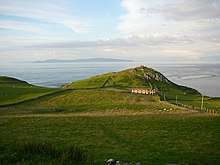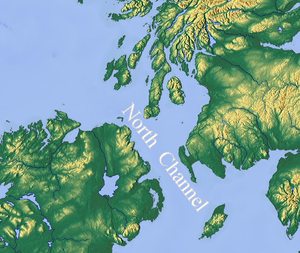North Channel (Great Britain and Ireland)
The North Channel or Irish Channel (known in Irish and Scottish Gaelic as Sruth na Maoile, in Scots as the Sheuch[1]) is the strait between north-eastern Northern Ireland and south-western Scotland.[2] It connects the Irish Sea with the Atlantic Ocean, and is part of the marine area officially classified as the "Inner Seas off the West Coast of Scotland" by the International Hydrographic Organization (IHO).[3]


The Straits of Moyle (Sruth na Maoile in Irish and Scottish Gaelic) or Sea of Moyle is the name given to the narrowest expanse of sea in the North Channel between northeastern Northern Ireland (County Antrim) and southwestern highlands of Scotland (Mull of Kintyre). The distance between the two shores is approximately 12 miles (19 km) at its closest point, and thus it is possible to see across in clear weather conditions. The Straits gave their name to Moyle District Council, a local government area in Northern Ireland, and are famed in Irish Celtic mythology through their association with the Children of Lir.
This strait was formerly known as the Irish Channel.[4][5][6] In the 19th century, Alexander Keith Johnston's suggested name St Patrick's Channel had currency, but it was rejected by the hydrographic department.[7]
The southern boundary of the strait is a line joining the Mull of Galloway and Ballyquintin Point. The northern boundary is a line joining Portnahaven and Benbane Head. The narrowest part of the strait is between the Mull of Kintyre and Torr Head where its width is 21 kilometres (13 mi; 11 nmi).[8] The deepest part is called Beaufort's Dyke.
The Channel was a favourite haunt of privateers preying on British merchant shipping in wars until the 19th century; in 1778, during the American Revolutionary War it was also the site of a naval duel between American captain John Paul Jones's USS Ranger and the Royal Navy's HMS Drake. It is crossed by many ferry services. In 1953, it was the scene of a serious maritime disaster, the sinking of the ferry Princess Victoria.
In Northern Ireland, Unionist political leaders for decades lobbied the British government to construct a railway tunnel under the Channel, to better link Northern Ireland with the rest of the United Kingdom. In August 2007 the Centre for Cross-Border Studies proposed the construction of a 34-kilometre-long (21 mi) long rail bridge or tunnel, estimating that it might cost about £3.5 billion.[9] In the Victorian era, engineers proposed a rail tunnel between Stranraer and Belfast.[10]
Swimming
The Irish Long Distance Swimming Association (ILDSA) has provided authentication observers for swimmers attempting to cross the approximately 35-kilometre (22 mi) span between Northern Ireland and the Mull of Galloway. According to the ILDSA, this was first accomplished in 1947 by Tom Blower.[11] The first two-way crossing was completed by a six-person relay team on 28 July 2015.[12]
The North Channel is part of the Ocean's seven, a set of seven long-distance open-water swims considered the marathon swimming equivalent of the Seven Summits mountaineering challenge.
Bridge proposal
In February 2020, the Prime Minister's Office announced that it had initiated work to examine the feasibility of bridge between Scotland and Northern Ireland.[13] The shortest route – 16 km (10 mi) coast to coast[14] – is that between Campbeltown on the Kintyre peninsula (about 220 km (140 mi) from Glasgow via minor roads) and Ballycastle, County Antrim (about 90 km (56 mi) from Belfast). The shortest route between Glasgow and Belfast is the route used by the existing ferry service, that via Portpatrick/Stranraer (about 150 km (93 mi) from Glasgow) and Larne (about 35 km (22 mi) from Belfast), a coast-to-coast distance of 45 kilometres (28 mi).[15] This route would require the bridge towers to be erected through Beaufort's Dyke, a 200–300 m (700–1,000 ft) deep trench, heavily contaminated by 'large quantities' of munitions ('small arms, high explosives and incendiary devices').[16][17]
First Minister of Scotland Nicola Sturgeon said her mind was not closed to the idea but added "if he [the prime minister] has got £20bn to build such a bridge going spare at the moment - that could be spent on more important priorities".[13]
See also
References
- Online Scots Dictionary. Retrieved 27 February 2017.
- 2007 annual report Archived 3 July 2013 at the Wayback Machine Tourism Ireland. Retrieved 9 August 2012.
- "Limits of Oceans and Seas, 3rd edition" (PDF). International Hydrographic Organization. 1953. Archived from the original (PDF) on 8 October 2011. Retrieved 7 February 2010.
- A Friend (1824). Glympses Across the Irish Channel.
- Old Sailor (1820). A view of the British and Irish fisheries. p. 74.
- Rooke, John (1838). Geology as a science applied to the reclamation of land from the sea. Ridgway. pp. 41.
- Andrews, John Harwood (January 1997). Shapes of Ireland: maps and their makers 1564–1839. Geography Publications. p. 88. ISBN 978-0-906602-95-9. Retrieved 18 September 2010.
- North Channel, Encyclopædia Britannica. Retrieved 2016-05-02.
- "Bridge to Northern Ireland mooted". BBC News Online. 22 August 2007. Retrieved 9 October 2011.
- McKenzie, Steven (9 October 2011). "Scotland–Ireland undersea rail link plan 'a surprise'". BBC News Online. Retrieved 9 October 2011.
- "North Channel". Irish Long Distance Swimming Association. Archived from the original on 20 November 2015. Retrieved 14 October 2015.
- Cowie, Jonathan (16 August 2015). "Two relay records set in the North Channel". H2Open. Archived from the original on 14 October 2015. Retrieved 14 October 2015.
- "Work 'under way' into Scotland-Northern Ireland bridge feasibility". BBC News. 10 February 2020. Retrieved 13 February 2020.
- Chris Kilpatrick (25 August 2012). "Man aims to be first to cross the treacherous 10 miles from Scotland to Torr Head". Belfast Telegraph. Retrieved 13 February 2020.
- "Irish Sea bridge: Scoping work begins on Boris Johnson's 'ambitious' idea". ITV news. 10 February 2020. Retrieved 13 February 2020.
- "Case study: Munitions Dumping at Beaufort's Dyke" (PDF). gov.scot. Fisheries Research Services (an agency of the Scottish Executive). Retrieved 13 February 2020.
- Dan Sabbagh (14 February 2020). "Bombs dumped in Irish Sea make bridge plan 'too dangerous': Experts pour cold water on Boris Johnson's idea for Scotland-Northern Ireland link". The Guardian. Retrieved 15 February 2020.
External links
- https://web.archive.org/web/20111102211623/http://www.bbc.co.uk/northernireland/ashorthistory/archive/intro19.shtml (accessed 4 March 2007)